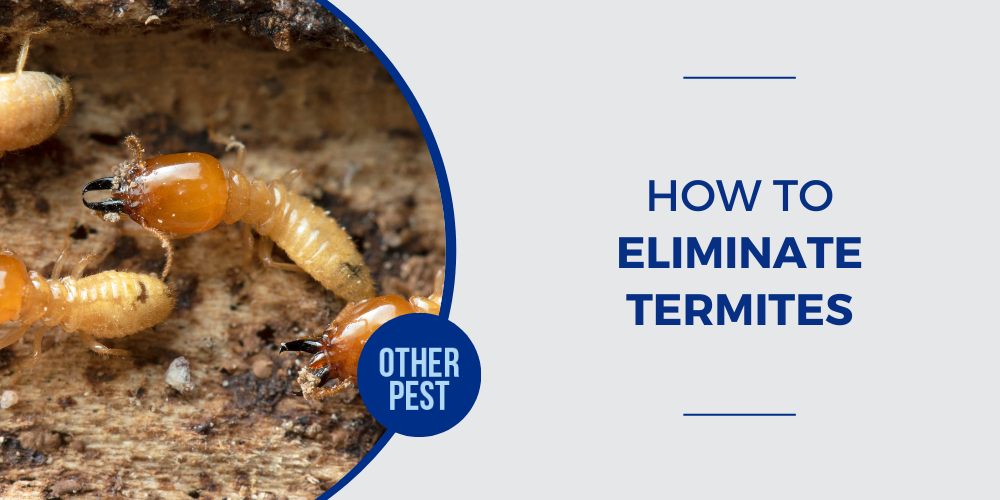Termites are one of the costliest pests to combat in Arizona. Unlike creepy crawlies like spiders or scorpions whose main threats are bites, termites can cause extensive damage to homes and other buildings. These small, destructive pests eat through wood and other home materials, mounting homeowners with both the cost of eliminating the termites and the necessary home repairs. There is no need to panic at the first sign of termites though, major damage can take some time and we can help you eliminate termites yourself before they destroy your home.
What do termites look like?
The first step to eliminating termites is to identify which type of termite has made themselves at home. Not all termites look or behave alike, so it’s important to identify the type of termite you’re dealing with in order to treat them effectively. The two most common types of termites found in Arizona are desert subterranean termites and drywood termites.
Desert subterranean termites
These are the most common termites in Arizona. They need to keep in contact with soil, using it as a building block for the tunnels they make to invade above-ground wood. These termites are approximately ⅜” long, with pale, yellowish-brown bodies and rectangular heads.
Drywood termites
Although drywood termites are not as common, the damage they can cause is often much more severe than desert subterranean termites. They get their name because they are capable of infesting dry wood that doesn’t touch the ground. Drywood termites are about ½” long, with oval bodies, and range in color from yellow to brown.
Termite castes
Termites live in colonies made up of three castes: workers, soldiers and reproductives. The members of different castes also vary in appearance.
Workers
These are the smallest but arguably the most important to the colony. Their role includes tasks such as collecting food, building nests and anything involved with maintaining the nest. Subterranean and drywood worker termites look similar with long, light-colored, wingless bodies.
Soldiers
These termites are responsible for protecting the nest and the termites that live in it. If another insect breeches the colony, the soldier ants retaliate immediately. Desert subterranean termites have large mandibles, flat, wide bodies, teeth and no wings. Drywood termite soldiers have large, yellowish-brown heads and strong, toothed mandibles that are covered in armor.
Reproductives
As the name implies, reproductives are responsible for reproducing and keeping the colony going for future generations. This includes the king and queen of the colony. The queen of the colony has a special role, being the most important and fertile termite. Both desert subterranean of reproductives are darker, ranging in color from dark brown to black, and they have two pairs of wings.
How to tell if you have termites
Because termites prefer higher temperatures and low humidity, the Sonoran Desert is a perfect climate for them to thrive. Signs of a termite infestation will depend on the type of termite. Since they spend most of their time in tunnels or wood, it isn’t likely a homeowner will see termites scurrying around. To check for termites homeowners need to inspect the home for cracks where termites can enter and look for mud tubes on outside walls. Using a screwdriver to tap the wood around a home every few inches is another good way to tell if there is termite damage. If damage is present, tapping will result in a hollow sound, or in extreme cases the wood will break.
Termites’ main food source is the cellulose found in wood. Considering most homes are built out of wood, they are an easy target for a termite infestation. In addition to wood, termites can chew through other softer materials such as drywall, foam, plastic and thin sheets of lead.
Termite damage
Termite colonies are found underground, often outdoors, in plants, dead cactuses, wood piles, and other wood sources like building walls. When termites find their way inside your home, they can cause irreversible damage. Desert subterranean termites and drywood termites leave behind different signs of damage.
Desert subterranean termites
Brown tubes or tunnels
The most obvious sign of desert subterranean termite damage are brown tubes or tunnels found outside called “mud tubes.” Termites use these tubes to travel from the ground to the wood they infest. Simply getting rid of a tunnel will not solve the issue though. Termites will continue to build tunnels, replacing those that were destroyed in only a matter of days.
Pocked wood
Desert subterranean termites leave behind a pocked appearance on wood after they eat. They like to eat along the grain of soft wood, which leaves a distinct honeycomb pattern.
Drywood termites
Wood blisters
This type of damage can often resemble water damage. Bubbling or peeling of paint or wood is the most common sign of dry wood termites.
Sawdust-like piles
Termite feces look like sawdust and can be found both inside and outside the home. The size of these piles depends on how many termites there are in a colony, but they are typically easy to spot.
Another clue that termites might be hanging around is if a home starts to have a musty smell similar to mildew or mold. Many people notice the smell of termites before the actual damage to wood. The odor can vary from mild to intense depending on the species and how many termites there are.
Termite control
No matter which type of termite you have, it’s important to get rid of them as soon as possible. Termite damage often lowers the value of a home and most homeowner’s insurance policies don’t cover termite damage. Major damage can take a while to occur, so it’s important to get ahead of termites as soon as their presence is suspected.
How to eliminate termites:
Cut off the food supply.
Termites show interest in a home because it provides adequate resources for a colony. If you take away those resources, the home becomes less desirable. Although keeping wood piles close to the home may be convenient, it is also attractive to unwanted pests. Keep any wood-based product in proper storage, away from the sides of the home.
Remove excess water.
Any water sources around the home such as A/C drip lines or faucets that could be leaking and causing excess water to pool should be sealed. Another often-overlooked cause of termite infestations is clogged gutters and leaf debris. Clogged gutters cause water to back up and leaf debris will collect moisture and begin to decay, giving termites the perfect supplies to build their tunnels.
Apply chemical barriers
Applying a chemical barrier around the perimeter of a home is one of the best ways to keep termites from entering a home. The chemical will absorb into the ground, cutting off the termite's path inside. These barriers are completely safe for surrounding plants and animals, but they will keep termites and other pests out of the home.
Another chemical barrier option is a foam chemical. Instead of spraying around the outside of the home, the foam is inserted through a small hole in the wall. This is best for cases where there are definite tunnels in the home.
Getting rid of termites on your own can be simple and cost much less than calling in a pest control company. At Bug & Weed Mart we carry the same EPA-approved treatment products that licensed professionals use. Plus, we teach you how to safely and effectively apply them yourself. If you have questions about termites, or any other pests, call or visit one of our Valley-wide locations and we can help you find a solution.

